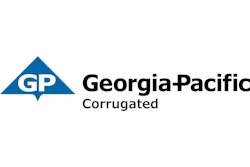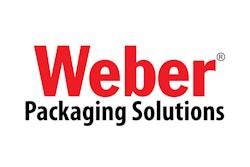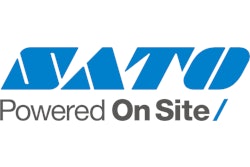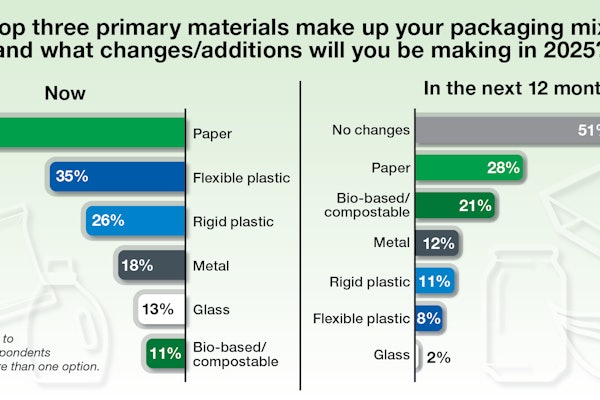The C-Pak, a three-piece package for sliced, shingled cheese, is helping Great Lakes Cheese Co. win new packaging business, most of which consists of private-label work for retailers who have their own store brands.
The innovative re-closable tray consists of a preformed bottom and lid that press together with a friction fit. Between these two parts is a clear flexible film that gets heat-sealed to the inner flange of the tray before the lid is pressed on. The consumer removes the snap-fit lid, peels away the flexible film lidding, extracts as many slices as desired, and then re-closes the package by snapping the lid back in place.
Slicing, shingling, tray loading, and tray sealing are all done on automated systems. GLC chooses not to identify the name of the slicing machine. But tray sealing and application of the snap-fit lid are done on a Mondini system from Harpak-Ulma. Tray de-nesting is also done automatically on a machine that sends trays to the infeed of the tray-sealing system. The tray de-nester is also a Mondini machine from Harpak-Ulma. In fact, Harpak-Ulma handled the design, installation, and integration responsibilities for the entire line from beginning to end. Placement of the cheese can be seen in Figures A and B on page 41. The cheese is conveyed forward in 10-slice stacks that are in a 4x4 pattern (Figure A). The preformed trays, meanwhile, are conveyed into position beneath the conveyor holding the stacks of cheese. As the conveyor holding the cheese retracts, each of the 16 stacks of cheese slices drops a very short distance into the trays (Figure B). Then the cycle repeats itself.
The trays move next into the evacuation/backflush chamber of the Mondini tray sealer. A mix of nitrogen and carbon dioxide helps give the cheese a six-month refrigerated shelf life. Also assisting on the shelf life are the packaging materials used, all of which come from Winpak. The tray, chiefly polypropylene, is thermoformed from a coextruded sheet that includes an oxygen barrier layer. The flexible film lidding material is a multilayer coextrusion that also includes an oxygen barrier layer. The snap-on lid is thermoformed of high-impact polystyrene.
Once the flexible film lidding is applied, the trays move next into a station where the preformed HIPS lids are automatically applied to the trays. Unlike most such applications, where the lid is snapped onto the tray flange, in this case the lid is snapped into a channel running around the perimeter of the tray. This patent-pending closing concept from Harpak keeps contents fresh and moist longer than conventional sliced cheese packaging formats.
One of a kind?
According to GLC package engineering manager Stew Armstrong, GLC is the only user of the C-Pak at this point in time. It was designed to meet a number of objectives, he says.
“Sliced cheese is usually sold in a flow wrap with a zipper along the side. When you go to get a piece of cheese out of that package, you can’t really do it without handling most of the other slices. With this package, because the lid is removable and you’re not trying to access the cheese from the side, you can extract one piece cleanly and conveniently without touching any other pieces.”
Armstrong says the concept of the shingled slices of cheese in a rigid tray as opposed to a flexible zippered package is popular in Europe and has been for at least the past five years. But usually the packaging consists of a rigid tray and peel/reseal lidding with no rigid lid like the GLC pack has. This certainly works well enough, but the tendency in Europe is to have just five slices of cheese in these packs.
“We have 10 slices in our packs,” says Armstrong, “and the peel/re-seal just doesn’t hold up to the amount of re-sealing that has to be done with a 10-slice pack. The snap-fit lid does. So we took the tray concept popular in Europe and improved upon it to meet the needs of the U.S. marketplace.”
Sealed, lidded trays emerge from the Mondini system four across. A gating mechanism creates two lanes from four, and each lane leads to checkweighing, metal detection, labeling, and date-coding. The check-weighing and metal detection are done on a Mettler Toledo Safeline system. An Accraply top-and-bottom pressure-sensitive labeler puts an attractive label bearing store brand information on the lid of the tray and an informative label with nutrition facts and other data on the bottom of the tray. An ink-jet printer from Videojet applies the date code on the side of each tray.
Once trays get past labeling, the two separate streams are merged back into one for transfer to case packing.
Retail-ready
Trays of cheese are placed into retail-ready cases supplied by Georgia Pacific. “It’s a wraparound case that’s perforated so that the top and side can be ripped off and the whole retail-ready unit of 12 can be placed on the store shelf,” says Armstrong. “Here again is where this C-Pak format is so much better than the wallet-style package made of flexible film. While the C-Pak stands up and displays beautifully in the retail-ready corrugated, it can also be hung on a peg or stacked flat in a well.”
Case erecting and case packing are done on a Model FW749 wraparound system supplied by CAMA. Its conveyor connections and sweep arms take trayed cheese on a forward, left, forward, left, forward trajectory. Just ahead of the actual case packer is an infeed stacker from CAMA that pivots up and down to stack trays six-high in a flighted conveyor that moves perpendicular and to the left of the infeed stacker. A sweep arm pushes two stacks at a time at a right angle so that a second sweep arm can push the 12 trays of cheese into a case that’s been pulled from a magazine feed and erected. From there the cases are pushed forward so that flaps can be folded and adhesive applied.
Cases exiting the CAMA system receive two identical labels: one on the side and one on the trailing edge. A print-and-apply labeler from Weber Marking Systems fitted with a Sato thermal-transfer print head delivers these labels with a pair of tamp applicators.
An incline conveyor takes cases to a palletizer/stretch wrapper from Top Tier. Each time it forms a layer, that layer is lowered onto a stretch wrapper turntable and a stretch film is applied. Armstrong likes the way in which the Top Tier machine builds pallet layers immediately above the space where stretch wrap is applied because it eliminates the need to have a separate stretch wrapper occupy valuable floor space.
The packaging line viewed during PW’s visit to the Plymouth plant was the first of three C-Pak lines GLC now operates. A second one in the Plymouth plant is used to produce 2-lb shingled cheese that is sold primarily through the club store channel. And in GLC’s Wausa, WI, plant, another C-Pak system produces 10-oz snack packs of cracker-sized cheese slices in what looks like a “butter dish.”
As for the cost of the C-Pak format, Armstrong admits it’s a little more expensive. But consumers have shown a willingness to pay a little more for the package because it is so much more practical and convenient. “They also like not having to mess with those bits of white paper that are used to separate slices in the wallet-style packs,” adds Armstrong. “With this package, the slices are so easily removed there’s no need for the separators.”






































